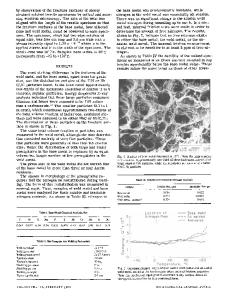Inverse Thermal Analysis of 304L Stainless Steel Laser Welds
- PDF / 497,430 Bytes
- 7 Pages / 593.972 x 792 pts Page_size
- 1 Downloads / 376 Views
JMEPEG (2013) 22:2141–2147 DOI: 10.1007/s11665-013-0500-8
Inverse Thermal Analysis of 304L Stainless Steel Laser Welds S.G. Lambrakos (Submitted November 14, 2012; in revised form January 30, 2013; published online March 2, 2013) An inverse thermal analysis of 304L stainless steel laser welds is presented. This analysis employs a methodology that is in terms of analytical basis functions. The results of this analysis provide parametric representations of weld temperature histories that can be adopted as input data to various types of computational procedures, such as those for prediction of solid-state phase transformations. In addition, these temperature histories can be used to construct parametric-function representations for inverse thermal analysis of welds corresponding to other process parameters or welding processes whose process conditions are within similar regimes. Specific aspects of the inverse-analysis methodology employed that relevant to its understanding and further development are examined.
Keywords
modeling processes, stainless steels, welding
1. Introduction An inverse thermal analysis of 304L stainless steel laser welds is presented. This analysis provides a parameterization of temperature histories for prediction of properties within the Heat Affected Zone (HAZ) of welds for the regime considered. The results of this analysis provide parametric representations of weld temperature histories that can be adopted as input data to various types of computational procedures, such as those for prediction of solid-state phase transformations and associated software implementations. In addition, these weld temperature histories can be used for construction of numerical basis functions that can be adopted for inverse analysis of welds corresponding to other process parameters or welding processes whose process conditions are within similar regimes. The construction of temperature fields according to spatially and temporally distributed constraint conditions using linear combinations of optimal basis functions represents a highly convenient approach to inverse analysis of energy deposition processes. Basis functions can be terms of either analytic or numerical function representations, or both in linear combination. The organization of the subject areas presented here are as follows. First, a brief description of the general procedure for inverse analysis of heat deposition processes is presented.
S.G. Lambrakos, Center for Computational Materials, Code 6390, Materials Science and Technology Division, Naval Research Laboratory, Washington, DC. Contact e-mail: samuel.lambrakos@ nrl.navy.mil.
Journal of Materials Engineering and Performance
Second, a description of the experimental measurements adopted for inverse thermal analysis of 304L stainless steel laser welds is presented. Third, results of inverse thermal analyses of these 304L stainless steel laser welds are presented. These results provide a quantitative parametric representation of temperature histories for these welds and for any welds asso
Data Loading...











